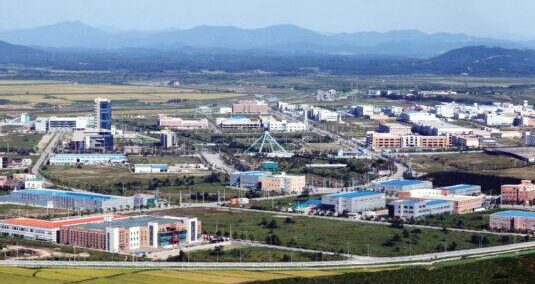North Korea (DPRK) - 개성 공업지구

The Kaesong Industrial Region started operations in 2004 to attract investment from South Korea into the country. It is a special administrative industrial region of North Korea (DPRK).
Attracting South Korean Investment at Kaesong Industrial Region
Established in 2004, the Kaesong Industrial Region was envisioned as a strategic move to draw investment from South Korea into North Korea (DPRK). This special administrative industrial region aimed to foster economic cooperation between the two neighboring countries.
Located approximately ten kilometers north of the Korean Demilitarized Zone, the Kaesong Industrial Region enjoys a unique geographical position. It is just an hour’s drive from the South Korean capital, Seoul, and boasts direct road and rail connections to South Korea. This accessibility enhances the potential for cross-border economic integration.
The core objective of the Industrial Region was to provide a Korean-speaking low-wage workforce. This ambitious goal aimed to leverage North Korea’s labor pool to complement South Korean businesses, contributing to economic growth and enhanced collaboration.
Navigating Challenges and Political Landscape at Kaesong Industrial Region
Despite its initial promise, the Kaesong Industrial Region faced its share of challenges. In February 2016, the South Korean government decided to close the complex, and all employees were recalled. Since then, the park has remained inactive, leaving its future uncertain. Occasional expressions of reopening have been made, but the fate of this venture is deeply intertwined with the evolving political landscape between North and South Korea.
A Complex Venture with Uncertain Prospects
At the height of its activity, the Kaesong Industrial Region employed around 53,000 DPRK staff, reflecting its potential as an economic catalyst. However, the complex geopolitical dynamics have significantly impacted the region’s trajectory.
The fate of the region continues to be influenced by broader political considerations, often overshadowing its economic potential. While the ambition of fostering economic cooperation between North and South Korea remains, the realization of this vision hinges on diplomatic developments and regional dynamics.
Despite its current closure, the Kaesong Industrial Region remains a symbol of the complexities and aspirations of cross-border economic collaboration. The future holds the possibility of reactivating this ambitious venture, with its strategic location and workforce potential standing as promising assets. As regional relations evolve, the path towards revitalizing the Kaesŏng Industrial Region may yet unfold, presenting fresh opportunities for economic cooperation and growth in the Korean Peninsula.
Around 53,000 DPRK staff were employed at its height of activity.
North Korea Takes Full Control of Kaesong Industrial Complex Amid Rising Tensions
At the beginning of 2024, South Korea announced the dissolution of the Kaeseong Industrial District Foundation, the sole government-run body overseeing the now-shuttered Kaesong Industrial Complex. This move, driven by ongoing inter-Korean tensions and Pyongyang’s hardened stance on denuclearization, follows President Yoon Suk Yeol’s directive for administrative restructuring. While the foundation will cease operations, South Korea’s Unification Ministry will continue supporting former Kaesong factory operators through alternative agencies.
North Korea, meanwhile, has escalated efforts to repurpose the industrial park for its own economic goals. Reports suggest that Pyongyang is relocating South Korean-owned machinery and equipment from Kaesong to factories in provincial regions, aligning with its ambitious “20×10 regional development policy.” This policy aims to revitalize 20 counties annually over the next decade. Surveillance assets, including satellite monitoring, are crucial to tracking these developments and potential violations of international agreements.
Closure of complex
Since its establishment in 2004, the Kaesong Industrial Complex symbolized inter-Korean economic cooperation, blending South Korean investment with North Korean labor. However, its closure in 2016, triggered by North Korea’s fourth nuclear test, effectively ended joint operations. The recent dismantling of facilities and relocation of industries further signals North Korea’s strategic pivot away from economic ties with the South.
North Korean authorities have officially reassigned Kaesong’s factories under the jurisdiction of the Kaesong City Local Industrial Bureau. The transition aligns with Pyongyang’s broader shift in policy, having declared South Korea its primary adversary in early 2024 and terminating all economic cooperation. By absorbing Kaesong’s industrial infrastructure, North Korea is reinforcing its economic self-reliance while deliberately erasing traces of South Korean involvement.
For South Korean business owners who had hoped to reclaim equipment left behind, this development delivers a significant blow. North Korea’s state-controlled trading companies, once utilizing Kaesong’s machinery to fulfill Chinese export orders, will now be unable to operate under those arrangements. Instead, North Korean leadership is integrating these assets into a nationalized industrial framework, strengthening its domestic economy while solidifying its separation from the South.
